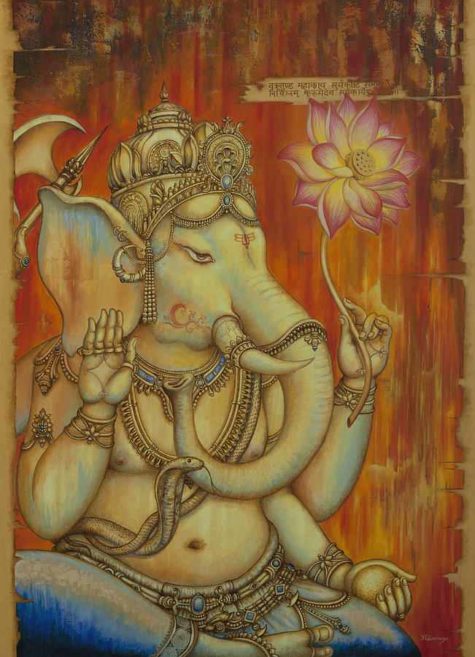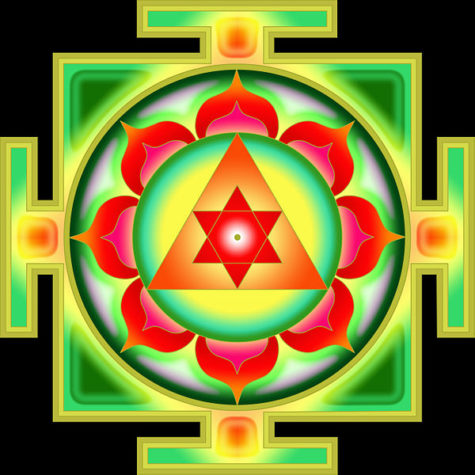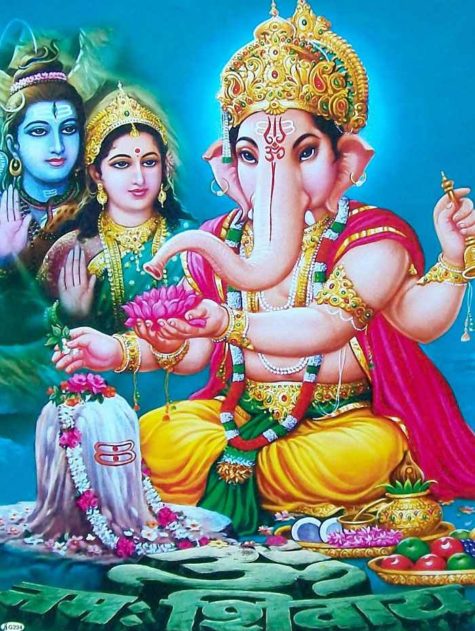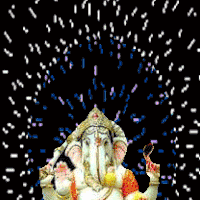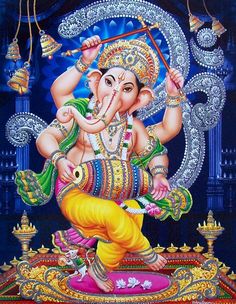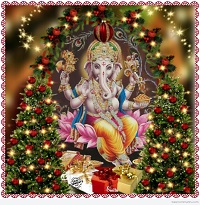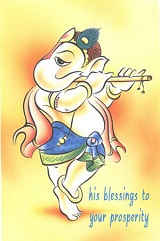Monthly Archives: September 2018
Shlokas on Lord Ganesha
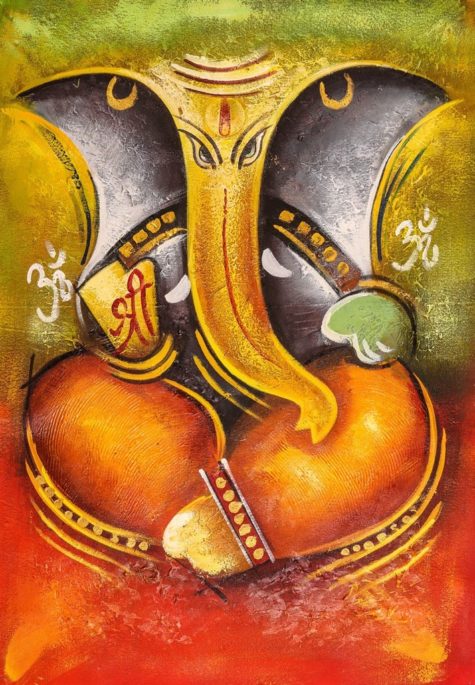
What is a Shloka?
Shloka is a Sanskrit word referring to a verse, proverb, hymn or poem that uses a specific meter. It is considered as the classic basis for epic Indian poetry as its use is widespread in traditional Sanskrit poems. Among the famous texts written entirely in shlokas are the “Ramayana” and “Mahabharata.”
Technically, a shloka can be made up of any sort of four-line stanza with up to 26 letters in a single line. In terms of yoga practice, it is likely that a yogi who meditates will come across this classical form of verse in the mantras that can help one meditate effectively.
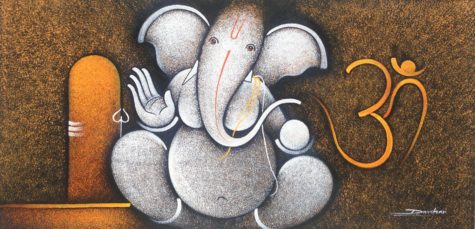
Shlokas on Lord Ganesh:
Shuklaambara Dharam Vishnum
Shashi Varnam Chatur Bhujam
Prasanna Vadanam Dhyaayet
Sarva Vighna Upashaanthaye
Meaning: We meditate on Lord Ganesha – who is clad in white (representing purity), who is all pervading (present everywhere), whose complexion is gray like that of ash (glowing with spiritual splendor), who has four arms, who has bright countenance (depicting inner calm and happiness) and who can destroy all obstacles (in our spiritual and worldly path).

Vakratunda Mahakaaya
Suryakoti Samaprabha
Nirvighnam Kuru Mey Deva
Sarva Kaaryeshu Sarvada
Meaning: The Lord with the curved trunk and a mighty body, who has the luster of a million suns, I pray to thee Oh Lord, to remove the obstacles from all the actions I intend to perform.

Agajaanana Padmaarkam
Gajaananam Aharnisham
Anekadantham Bhaktaanaam
Ekadantam Upaasmahey
Meaning: I worship day and night that elephant faced Lord Ganesha who is like sun to the lotus face of Mother Parvati. Giver of many boons, the single tusked Ganesha, I salute Thee to give me a boon.

Gajaananam Bhoota Ganaadhi Sevitam
Kapitta Jamboophaala Saara Bhakshitam
Umaasutam Shoka Vinaasha Kaaranam
Namaami Vighneswara Paada Pankajam
Meaning: The Lord with the elephant face, served by all the Ganas, One who takes as His food, the essence of Kapitta and Jamboophala (these are two favorite fruits of Ganesha), son of Uma (Mother Parvati), destroyer of misery of the devotees, controller of obstacles, we worship Your Lotus Feet.

Ganaanaam Twam Ganapathi Gam Havaamahe
Kavim Kaveenaam Upamasra Vastamam
Jyeshta Raajam Brahmanaam Brahmanaspatha
Aanashrunvanna Oothibhi Seedha Saadanam
Meaning: We invite You, the Lord of spiritual faith (of Lord Shiva). You are the wisest among the wise, the best to be given as a standard of comparison. You are the senior Lord, Lord of the Vedic mantras, listening to our prayers. Please visit our home with prosperous things and be seated here.
 GANESH GAYATHRI
GANESH GAYATHRI
Tatpurushaaya Vidmahe
Vakratundaaya Dheemahe
Tanno Danthihi Prachodayaat
Meaning: We meditate on that super power, we invoke the single tusked boon giver, Ganesha.

GANESHA PANCHARATNAM
Mudakaraatha Modakam Sada Vimukti Saadhakam
Kalaadharaavatamsakam Vilasiloka Rakshakam
Anaaya Kaika Naayakam Vinasitebha Daityakam
Nataasubhasu Naashakam Namaami Tham Vinaayakam.
Meaning: I prostrate before Lord Vinaayaka who joyously holds modaka in His hand, who bestows salvation, who wears the moon as a crown in His head, who is the sole leader of those who lose themselves in the world. The leader of the leaderless who destroyed the elephant demon called Gajaasura and who quickly destroys the sins of those who bow down to Him, I worship such a Lord Ganesha.

Natetaraati Bheekaram Navoditaarka Bhaasvaram
Namat Suraari Nirjanam Nataadhi Kaapa Duddharam
Suresvaram Nidheesvaram Gajesvaram Ganeshvaram
Mahesvaram Samaasraye Paraatparam Nirantaram.
Meaning: I meditate eternally on Him, the Lord of the Ganas, who is frightening to those not devoted, who shines like the morning sun, to whom all the Gods and demons bow, who removes the great distress of His devotees and who is the best among the best.

Samasta Loka Samkaram Nirasta Daitya Kunjaram
Daredarodaram Varam Vare Bhavaktra Maksharam
Krupaakaram Kshamaakaram Mudaakaram Yasaskaram
Manaskaram Namaskrutaam Namaskaromi Bhaasvaram.
Meaning: I bow down with my whole mind to the shining Ganapati who brings happiness to all the worlds, who destroyed the demon Gajasura, who has a big belly, beautiful elephant face, who is immortal, who gives mercy, forgiveness and happiness to those who bow to Him and who bestows fame and a well disposed mind.

Akimchanaarti Marjanam Chirantanokti Bhaajanam
Puraari Poorva Nandanam Suraari Garva Charvanam
Prapancha Naasha Bheeshanam Dhananjayaadi Bhushanam
Kapola Daana Vaaranam Bhajaey Puraana Vaaranam.
Meaning: I worship the ancient elephant God who destroys the pains of the poor, who is the abode of Aum, who is the first son of Lord Shiva (Shiva who is the destroyer of triple cities), who destroys the pride of the enemies of the Gods, who is frightening to look at during the time of world’s destruction, who is fierce like an elephant in rut and who wears Dhananjaya and other serpents as his ornaments.

Nitaantikaanta Dantakaanti Mantakaanta Kaatmajam
Achintya Rupa Mantaheena Mantaraaya Krintanam
Hrudantarey Nirantaram Vasantameva Yoginam
Tameka Danta Meva Tam Vichintayaami Santatam.
Meaning: I constantly reflect upon that single tusked God only, whose lustrous tusk is very beautiful, who is the son of Lord Shiva, (Shiva, the God of destruction), whose form is immortal and unknowable, who tears asunder all obstacles, and who dwells forever in the hearts of the Yogis.

Mahaaganesa Pancharatnam Aadarena Yonvaham
Prajapati Prabhaatake Hrudi Smaran Ganesvaram
Arogatham Adoshataam Susaahitim Suputrataam
Samaahitaayu Rastabhootim Abhyupaiti Sochiraat.
Meaning: He who recites this every morning with devotion, these five gems about Lord Ganapati and who remembers in his heart the great Ganesha, will soon be endowed with a healthy life free of all blemishes, will attain learning, noble sons, a long life that is calm and pleasant and will be endowed with spiritual and material prosperity.
From: Saidarshan.org
Twelve Names of Ganesha

We already explored the 108 names of Ganesh, but these twelve names are in the form of a shloka, which is a verse, proverb, hymn or poem that uses a specific meter. This group of verses is said to be sage Narada’s offering to Lord Ganesh. So, if you like doing these Sanskrit chants, here are some more. I think this is meant to be recited in its entirety, rather than bits and pieces.

Pranamya Shirasa Devam
Gauriputram Vinaayakam
Bhakataavaasam Smare Nityam
Aayuh Kaamartha Siddhaye
Meaning: Every day, I bow down to that Lord, the son of Gowri, the Lord one who lives in the heart of the devotees, blessing them always with good health and prosperity.
Prathamam Vakratundam Cha
Ekadantam Dviteeyakam
Thriteeyam Krishna Pingaaksham
Gajavaktram Chaturthakam
Meaning: Starting from here the twelve names of Ganesha are mentioned and he is worshiped in those different forms. The first as the Lord with the curved trunk; second, as the one with only one tusk, third, as the one with black (red/brown) eyes, fourth, as the one with giant structure.
Lambodaram Panchamaam Cha
Shashtam Vikatameva Cha
Saptamam Vighnaraajendram
Dhoomravarnam Tathaashtamam
Meaning: Fifth, as the one with a big (long) stomach, six, as the one with a huge body Seven, as the remover of obstacles, eight, as the one with smoke gray color
Navamam Phaalachandram Cha
Dasamam Tu Vinaayakam
Ekaadasam Ganapatim
Dvaadasam Tu Gajaananam
Meaning: Ninth, as the one with moon on the front of His head, tenth, as the foremost leader, eleventh, as the leader of the ganas, twelfth as the one with elephant face.
Dvaadasaitaani Naamaani
Trisandhyam Yah Pathernnarah
Na Cha Vighna Bhayam Tasya
Sarva Siddhikaram Prabho
Meaning: Any person, who remembers these twelve names of Ganesha, three times in a day, will have all their obstacles and fear removed and will attain success.
From: Saidarshan.org
Prayers To Ganesh
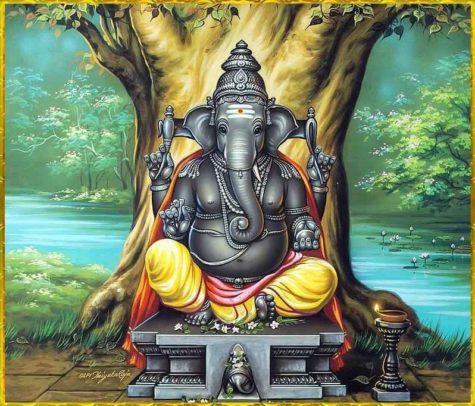
Here is an assortment of prayers for specific situations. These can be said aloud, or silently while visualizing Ganesh or looking at an image of Him. A nice little ritual can also be made with these prayers. Here’s how:
- Light a candle and burn some sandalwood incense.
- Write the prayer on a piece of paper.
- Imagine that you are now putting that prayer, that request, that issue, that problem into the capable hands of the God.
- As you imagine the above, light the paper and allow it to burn completely.
- While the paper is burning let go completely of all worry, anxiety, fear, or need to control. Give it completely up.
- Disperse the ashes in running water.
![]()
Moments of Decision
Aum Sri Ganeshaya Namaha
Great Lord of Wisdom, here I stand with so many decisions to make, with so many ways to turn. I beg for your grace. Fill me with righteous judgment and clear discrimination as I lay all confusion at Your holy feet and immerse myself solely in You.
Aum Ganesha Sharanam Sharanam Ganesha
Times of Need
Aum Sri Ganeshaya Namaha
Ganapati, Lord of Ganas, I, too, am a deva under Your command. I know I can never ever separate myself from the intricate mind of the supreme intelligence. O Lord who destroys the obstacles of His devotees, grant me protection, guidance and help in this hour of need. (State your need or troubles.)
Aum Ganesha, grant me Your grace, Sharanam Ganesha
Family Welfare
O Lord Ganesha, holder of the noose and goad, sweets, fruits and sugarcane, please provide for the welfare of my family. Guide prosperity and abundance to our door. But while we wait and mostly see only our wants and needs, please help us feel within our home Your goodness and Divinity, which no calamity can conceal.
Aum Ganesha Sharanam Sharanam Ganesha
Freedom from Fear and Anger
Omnipresent Lamboradara, pure and peaceful doer of all good. Take away my fear and anger. Let me see Thee everywhere and at all times. Show me the truth that there is no intrinsic evil. Remove all barriers in my mind to understanding, true trust, and love. Guide me to a harmonious life and righteous success in the fulfillment of my dharma.
Aum Ganesha Sharanam Sharanam Ganesha
Appreciation
Aum Sri Ganeshaya Namaha
Peerless One, industrious indweller in all, we see You in the full warmth of the Sun, in the full life of Earth and the orderliness of all the turning planets. O Lord and lover of intellect, You are the intricate knowledge blossoming in the mind of the people. O Lord who rules the mind of each and all who worship You, because of You, chaos never was nor will it ever be.
Aum Ganesha Sharanam Sharanam Ganesha
Morning Prayer
Aum Lord Ganesha, you make the flowers grow, You keep the Earth going around the Sun. All day You keep things going right. You are Lord of the devas. I am one of Your devas, too. Help me to think of the needso of others, and to be kind to everyone I meet. Help me to think of You first before beginning something new and to always do what is right and kind.
Aum Ganesha Sharanam Sharanam Ganesha
Bedtime Prayer
Aum, Lord Ganesha, nightime is here and the moon is in the sky above, reminding me of your crescent tusk. Remain with me, Ganesha, through the night, in my deepest sleep, in my inner experiences, as You have remained with me during my daytime, outer encounters. Let me never forget You, even in my dreams. May we as a family be guided by Your loving wisdom, even there.
Aum Ganesha Sharanam Sharanam Ganesha
from Loving Ganesha
by Satguru Sivaya Subramuniyaswami
Sixteen Names of Ganesha
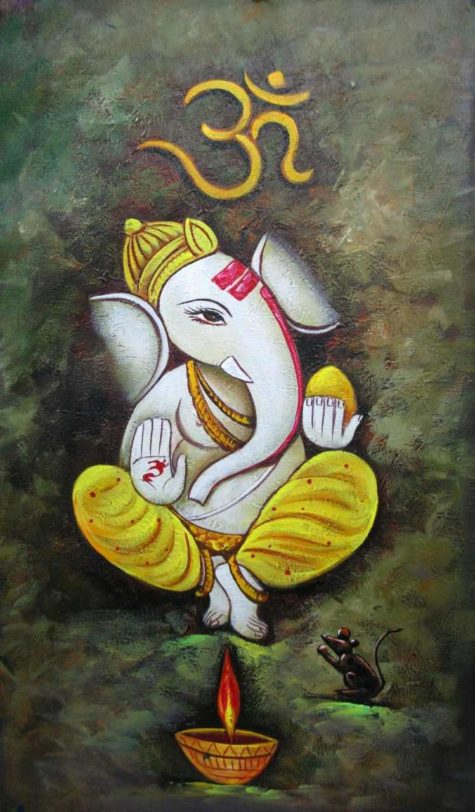
Sumukhascha Ekadanthascha
Kapilo Gajakarnakaha
Lambodarascha Vikato
Vighnaraajo Ganaadhipaa
Meaning: The various names and associated forms of God Ganesha are enumerated and need to be meditated upon here – the one with an auspicious face, the single tusked Lord, the one who is of red color, the one with the ears of an elephant, the one with a big stomach, the one with a jovial disposition, the controller of obstacles, the Lord of the Ganas.
Dhoomaketur Ganaadhyashah
Phaalachandro Gajaanana
Vakratundo Shoorpakarno
Heyrambho Skandapoorvajaha
Meaning: The one of smoke gray color, the leader of the ganas, the one who has moon in the front of his forehead, the elephant faced one, the one with a curved trunk (or broken tusk), the one with big (basket like) ears, the one who is heroic like a buffalo, the elder brother of Skanda (Skanda is another name for Lord Subrahmanya)
Shodashaitaani Namaani
Yah Pateth Srunuyaadapi
Vidyaarambhe Vivahe Cha
Praveshey Nirgamey Tatah
Sangraamey Sarva Kaaryeshu
Vighnas Tasya Na Jaayathe
Abheepsitaartha Siddhyartham
Poojitoya Surairapi
Sarva Vighna Chhido Tasmai
Sree Ganaadhipataye Namaha
Meaning: Whoever the one who recites and listens to these sixteen names at the beginning of studies, at the time of marriage, while entering or departing a place, or at the battle field, all their obstacles will be removed. Even the Gods worship Lord Ganesha to receive the fulfillment of their actions. Oh Lord Ganesh, the One who has this power of destroying all the obstacles in the way of the devotees, I prostrate before you.
From: Saidarshan.org
Other Ganesh Mantras
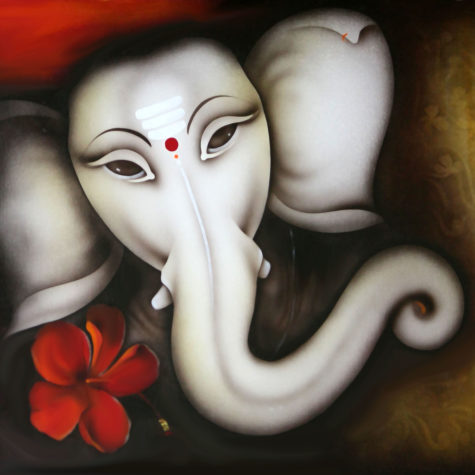
- Aum Shri Ganeshaya Namah.
This is the mantra of invocation, adoration and worship. It means ” Praise to Lord Ganesha“. It is repeated at the beginning of religious ceremonies and mantra recitation to invoke Ganesha’s blessings for the auspicious beginning of a task, project, change of life, community undertaking or simply to offer Him praise.
This mantra is usually taught to children for their good education. It increases their memory power, and they become successful in their examinations. Of course, people of any age may use this mantra when taking courses in a school or university, and for success in attaining their degree.
- Aum Gum Ganapataye Namaha.
This is Lord Ganesha’s mula (“root”) mantra. It is also known as His bija mantra, for it combines Ganesha’s bija (“seed”) sound, “gum,” with the phrase, “Praise be to Ganapati.” This is a mantra from Ganapati Upanishad. One may always use it before beginning a journey, new career or job, or before entering into any new contract or business so that impediments are removed and your endeavor may be crowned with success.
- Aum Vakratundaya Hum.
This is a very powerful mantra. When something is not working properly, individually or universally, nationally or internationally, or when the minds of the people turn crooked, negative, depressed or discouraged, the attention of Ganesha may be drawn by this mantra to straighten their ways. The HUM symbolizes “Delay no more, my Lord, in straightening the paths of the crooked-minded ones.”
In addition, this mantra could also be used for healing any spinal deficiency, such as curvature of the spine or curved limbs. Dedicate 1,008 repetitions of this holy word to straighten and heal such deficiencies.
- Aum Kshipra Prasadaya Namah.
Kshipra means instantaneous. If some danger or negative energy is coming your way and you don’t know how to get rid of that trouble, with true devotion, practice this mantra for quick blessing and purification of one’s aura.
- Aum Shrim Hrim Klim Glaum Gam Ganapataye Vara Varada Sarva Janamme Vashamanaya Svaha.
There are several bija (seed) mantras in this mantra . Among other things, it signals, “Shower Your blessings, O Lord. I offer my ego as an oblation.”
- Aum Sumukhaya Namah.
This mantra has a lot of meaning, but to make it simple, it means you will be always very beautiful in soul, in spirit,in face, everything. By meditating on this mantra, very pleasing manners and a beauty comes on you. Along with that comes peace, which constantly dances in your eyes; and the words you speak are all filled with that power of love.
- Aum Ekadantaya Namah.
Ekadanta refers to one tusk in the elephant face, which means God broke the duality and made you to have a one-pointed mind. Whoever has that oneness of mind and single-minded devotion will achieve everything.
- Aum Kapilaya Namah.
Kapila (red) means that you are able to give color therapy. You are able to create colors around yourself and around others, bathe them in that color and heal them. As per the mantra you create, so will you create the colors. Another meaning is “wish cow,” the “cow of plenty.” It means that whatever you wish, that comes true. There is a wish-cow inside you. Whatever you wish, especially for healing others, comes true immediately.
- Aum Gajakarnikaya Namah.
The ears of Ganesha, the elephant, are constant fanning, which means people may talk a lot,but you are not receiving inside anything other than that which is important.It also means that you can sit anywhere and tune this cosmic television (the body) with seven channels (chakras) and all 72,000 nadis, to any loka and be able to hear ancestors, angels, the voice of God or the voice of prophets. That kind of inner ear you will develop through this mantra.
- Aum Lambodaraya Namah.
This means you feel that you are this universe. It means that all the universes are within you. Like an entire tree is in the seed, the whole universe is in the sound of creation, which is Aum, and that Aum consciousness in you makes you feel that you are the universe. Therefore, if you say, realizing the oneness with the universe, “shanti to the world” every day, then the grace of God will come and there will be world peace, universal peace. It is the universes within Aum and Aum within you.
- Aum Vikataya Namah.
This means realizing this world as a dream or a drama. When you are in that high consciousness, this whole world looks like a dream. All of us have taken a role. We have to play our role in life as wife or husband or children or citizens, all consistent with the role we have taken.
When an actor bitten by a sponge cobra that is brought on the stage falls, the entire audience cries; but that boy who has fallen knows it was not a real cobra and he is not dead. Life is a drama –definitely life in this material world, this physical world of ego, is a drama. But inside, like the boy on the stage who is quite happy knowing that he didn’t die by the bite of the sponge cobra, like that, the truth never dies in us; it is immortal. So everything else you consider as drama. That consciousness comes to you by knowing this mantra.
- Aum Vighna Nashanaya Namah.
This mantra invokes the Lord Ganesha to remove every impediment in your life and in your works. By constant meditation on this mantra, all obstacles and blocked energy in your physical and astral bodies are released.
- Aum Vinayakaya Namah.
Vinayaka is the name of Ganesha in the golden age. So by realizing this mantra, your life will have a golden age. In your office, in your work, you’ll be the boss. Vinayaka means something under control. Vinayaka means the Lord of problems.
- Aum Ganadhyakshaya Namah.
This mantra is so important. Suppose you have a group, a country, neighbors, or any kind of group therapy, group healing or a whole country needing healing, then you have to bring that entire group to your mind’s arena and say this mantra. A group healing takes place by this mantra.
- Aum Bhalachandraya Namah.
In Sanskrit, bhala means the forehead center. Chandra means the crescent moon. Bhalachandra means that chakra from where the nectar drips. That is the secret of all healing. It is to feel yourself as Siva, identifying yourself with the Truth and feeling constantly that you are carrying the crescent moon, the symbol of growth and nectar and peace.
from Loving Ganesa
by Satguru Sivaya Subramuniyaswami
Who Is Ganesha?
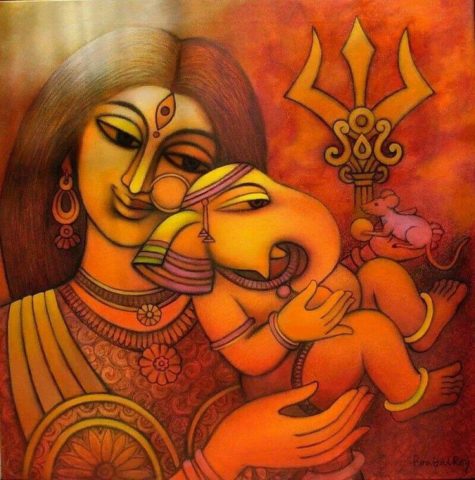
Ganesha is India’s cutest god. He has the head of an elephant on which is perched a dainty tiara, four pudgy hands joined to a sizeable belly with each hand holding its own symbolic object. One has a trishul, or a trident, the second, an ankush, or goad made from his very own broken tooth, the third hand elegantly holds a lotus and the fourth a rosary (which is sometimes replaced by modaks – his favourite sweet). His appetite for sweets is legendary and offerings of them are often left at his shrine.
Ganesha is famous not only for being a trickster and for his sense of humour, but equally for his wisdom. He is the son of Shiva (Destroyer in the Hindu Holy Trinity of Creator-Preserver-Destroyer) and Parvati (Shiva’s consort).
The chubby, gentle, wise, elephant-headed Ganesh, or Ganesha, is one of Hinduisms most popular deities. He is the remover of obstacles, the deity whom worshipers first acknowledge when they visit a temple. He is also patron of letters and of learning; he is the legendary scribe who, using his broken tusk, which he often holds, wrote down parts of the Mahabharata epic.
From Loving Ganesa
by Satguru Sivaya Subramuniyaswami
Lord Ganesha’s Tools
- Shankha
Conch
Ganesha listens to the puja conch’s loud sound, reminding Him of elephants’ trumpeting happily in the jungle. He summons, “Come one and all to Me and pray.”
- Ankusha
Goad
Loving Ganesha’s deliberate mind prods dullards on in their birth karmas whenever they tarry. with His ankusha He goads forward all souls that are moving too slowly.
- Parashu
Axe
Loving Ganesha knows there are difficult times ahead for some of His devotees. He protects them with His parashu in gentle ways from evils they have attracted.
- Pasha
Noose
Loving Ganesha’s provident mind, like the noose, draws close those He loves most dearly and reaches out to encircle and save strayed ones in extraordinary ways.
- Vajratrishula
Lightning Bolt
Loving Ganesha, like His brother Murugan, wields a sure weapon, the lightning bolt: spirit over mind, mind over matter, ruling both the higher and lower chakras.
- Chakra
Discus
Loving Ganesha holds the discus, symbol of the sun and of the mind, as the moon symbolizes the emotions. Employed as a weapon, it is the intellect divinely empowered.
- Modakapatra
Bowl of Sweets
Loving Ganesha is said to have a sweet tooth, or tusk. But the modaka ball is a symbol of what He loves most, moksha, liberation, the sweetest of all things sweet.
- Gada
Mace
Loving Ganesha is decisive and commanding, as symbolized by gada, His mace. He casts karmas back on devotees for resolution, never letting up until completion.
- Chhuri
Dagger
Loving Ganesha sometimes holds the dagger, keenly sharp, likened to the “razor’s edge,” the narrow and sometimes difficult path the spiritual aspirant must walk.
- Rudraksha Mala
Prayer Beads
Loving Ganesha sits at Lord Siva’s holy feet with japa mala, His prayer beads, in hand, waiting for instruction from the Supreme Lord of all the Gods, His father.
- Pushpashara
Flower Arrow
Loving Ganesha shoots flower-covered arrows from His sugar cane bow in guidance to devotees, so they will not wander too far from dharma’s path of true fulfillment.
- Amritakumbha
Pot of Nectar
Loving Ganesha receives a bath whenever a worshiper knocks his temples with arms crossed. The amrita flows from the sahasrara down to His seat at the muladhara’s base.
- Padma
Lotus
Ganesha wants devotees to learn confidence from the potential of the lotus flower: coming from the depths of the mud into the bud’s opening high above the water.
- Ikshukarmuka
Sugar Cane Bow
Loving Ganesha shows His generous nature of giving all that is good to devotees. His sugar cane bow shoots the kindest arrows, which are projections of His thought.
- Shara
Arrow
Loving Ganesha has power over thought, and each one hits its mark. Bow drawn, arrow aimed, He teaches us to precisely begin all undertakings with good intentions.
- Vina
Indian Lute
Loving Ganesha is sound in all its beauty and meaning. Siva is the ocean; Ganesha is its sound. Siva, the wind God; Ganesha its sound. Listen to the vina within and hear.
- Asura
Goblin
Loving Ganesha is not beyond frightening those who live in the chakra of fear by sending His ganas to lift them into a better life. Sometimes fear is a helpmate in need.
- Danda
Stick
Ganesha carries a short stick, a sign of authority, warning all not to impede the noble ways of dharma and restraining those who have as much as the thought to do so.
- Chamara
Fly-Whisk Fan
Loving Ganesha sits, as He always does, whisking away the past within the minds of devotees, young and old, rich and poor, educated and practical — because He is so wise.
- Kamandalu
Water Vessel
Loving Ganesha, dear to sannyasins, keeps their water vessel full. Symbol of fullness, meeting all needs, kamandalu eternally pours out, never needing to be filled.
- Dhanush
Bow
Loving Ganesha is discreet as He draws His bow and bends His thoughts into forms most helpful to His dear devotees. They all cherish all attentions with great ecstasy.
- Naga
Serpent
Loving Ganesha has a snake as His pet. Many are afraid of such creatures; but He tells us that it is the kundalini within all, and each one can rise above all adversity.
- Shalipallava
Rice Sprig
Loving Ganesha knows rice is the life-sustainer of villagers and city folk alike. Holding a sprig of paddy, He assures rains will come and all will be well at harvest time.
- Mudgara
Hammer
Loving Ganesha wields a mallet, badge of His office as Patron of Arts and Crafts, protector of all who build and shape, chisel and sculpt for the benefit of society.
- Shastra
Scripture
Loving Ganesha studiously edits all the scriptures on this planet and on others, too. His ever-ready, potent pen writes and edits life’s ordinances and comments on their meanings.
- Kalpavriksha
Wish-Fulfilling Tree
Loving Ganesha holds a sprig of the wish-fulfilling tree to tell us that all our wishes will be gratified. We have but to tell Him our needs, that is all, just tell Him.
- Parashvadha
Battleaxe
Loving Ganesha knows sometimes strong measures must be taken to fulfill a righteous goal, like crashing through a jungle. He uses a battleaxe as a mind force.
- Mahaparashu
Large Axe
Loving Ganesha often brandishes a big axe. This powerful weapon frightens off asuras and banishes malicious thoughts of those who intend harm to His devotees.
- Trishula
Trident
Loving Ganesha makes His way through the mind’s vast complexities with His abilities represented by trishula, His three-fold power: Love, Wisdom and Action.
- Narikela
Coconut
Loving Ganesha holds the coconut, symbol of the ego, soft and sweet inside, hard and rough outside. When we break a coconut to Him, we break the ego’s hold on us.
- Dhvaja
Flag
Loving Ganesha is the spirit of mirth. On festival days, the saffron Hindu dhvaja flies proudly over His temples, bringing crowds from near and far.
- Bhagnadanta
Broken Tusk
As the story goes, Ganesha broke off His right tusk in a sacrificial act to use it as a stylus while taking Vyasa’s dictation. Thus he teaches us that we must finish what we start.
- Pashanadarana
Pick Axe
Loving Ganesha is not naive by any means. He knows that trials await devotees, and that He must, in order to respond to prayers, pick, pick, pick away their mental dross.
- Agni
Fire
Loving Ganesha activates His fiery powers, capable of consuming our dross, of destroying our residual karmas, if we but consign our misdeeds to the purifying flames.
- Khadga
Sword
Loving Ganesha has a sword bejeweled with precious gems. It gives notice to those who respond only to fear of His enmity to crime and His abhorrence of hurting.
- Phala
Fruits
Loving Ganesha, dweller in the forest, enjoys all the Earth’s many life-sustaining fruits. He wants parents and children alike to stay healthy by eating lots of energy-giving fruits.
- Mulaka
Radish
Loving Ganesha, by His partiality for the simple radish, makes us grow food that is good for us. He knows devotees may grow more than they need just to please Him.
- Khetaka
Shield
Loving Ganesha holds the shield of divine security, symbol of His power to defend lands of the upright, to preserve traditions and to protect all souls on the spiritual path.
- Amra
Mango
Loving Ganesha says of the mango: “It was given to Me from Lord Siva’s own hand after performing My first wisdom act. It represents the highest spiritual fruition.”
- Tritiyakshi
Third Eye
Loving Ganesha, as do we all, has three eyes, not two, the third being the eye of the mind, of spiritual sight. With this eye He sees the reality behind the world’s seeming.
- Ratnakumbha
Pot of Gems
Loving Ganesha knows the magical power resident in gems. Diamonds, rubies, emeralds are like human souls, each with a different color, faceting, loveliness and value.
- Garitra
Grains
Loving Ganesha knows there are many kinds of people and they need variety in diet. He protects the cultivation of all kinds of grains that make their bodies strong.
- Ikshukanda
Sugar Cane
Loving Ganesha is fond of sugar cane, in fact, of anything sweet. Being the Lord all children adore, it is His joy to see their happy eyes light up when offering sugar cane.
- Madhukumbha
Pot of Honey
Loving Ganesha wears a wide smile across His face when offered a pot of sticky honey. It is, to Him, like moksha itself, the sweetest of all things sweet, worth any effort.
- Kadaliphala
Banana
Loving Ganesha has in His hand the banana, ripe and ready to eat. He looks at it longingly, yet would give it up in a moment should a devotee smell its fragrance.
- Yogadanda
Meditation Staff
Loving Ganesha rests His arm upon a short staff when talking to devotees and when in deep samadhi. He finds it helps Him meditate more effortlessly, more deeply.
- Trina
Grasses
Loving Ganesha knows that there are many kinds of animals, little and big. Each needs a special environment and foods, so He protects the grasses, little flowers and seeds.
- Tila Gola
Sesame Ball
Loving Ganesha teaches us that size may be immense but there is nothing too small to overlook. In His trunk is a sweet made of tiny sesame seeds, and He rides on a tiny mouse.
- Shuka
Parrot
Loving Ganesha delights when the parrot talks and shows he is happy. Perched in Ganesha’s hand, he greets all who come and go, giving his opinion when they are alone.
- Ananasa
Pineapple
Loving Ganesha holds the pineapple and is ready to slice it to share with those in His aura. Giving and sharing is our lesson from the sweet pineapple that He gives us.
- Mushika
Mouse
Ganesha’s companion, a mouse, attests to the all-pervasiveness of the elephant God. Mushika, the mount or vahana, carries Him into the mind’s every nook and cranny.
- Lambodara
Big Belly
Loving Ganesha has this world and all the billions of galaxies in His abundant belly. All known and unknown universes are contained within His prodigious girth.
- Swastika
Mark of Auspiciousness
Loving Ganesha’s good fortunes are represented by the swastika, a sign of luck and auspiciousness. Its crooked arms show how life is filled with change and indirection.
- Jambira
Lime
Loving Ganesha is a practical God, and it is His wish that all who know Him drink the juice from one of His favorite fruits. He wants them to be healthy and enjoy life.
- Aum
Cosmic Sound
Loving Ganesha is Aum. He is the A, the base sound of the universe; He is the U, the sound of the galaxies; and He is the M, the sound of the planets and the littlest stars.
- Shunda
Elephant Trunk
Loving Ganesha has a versatile trunk, and makes it known that it is a symbol of His capacity to always love His devotees. With it He reaches out to touch each of them.
- Nilapadma
Blue Water Lily
Loving Ganesha often sits by a lily pond, pondering the current state of the universe. His province is to see that all is in order until the next Great Dissolution, mahapralaya.
- Panasa Phala
Jackfruit
Loving Ganesha’s favorite, jackfruit, is a potato-like vegetable, a chewy nut and sweet yellow fruit all in one. Like the jack’s stem, our attachments, though small, are strong.
- Prabhavali
Fiery Arch
Loving Ganesha sits within an arch depicting creation, preservation and fiery dissolution. Above is the God of time, Mahakala, who ultimately claims everything.
- Dadima
Pomegranate
Loving Ganesha knows we may be led astray by ways of worldly people who eat meat. He offers us red dadimas, as if saying: “Its many pink seeds are so much better than flesh.”
- Nagapasha
Snake Cord
Loving Ganesha wears a snake around Him to tell us all that we have to be like Him and control our instinctive, animal mind. Yes, it is possible through the grace of this God.
- Kapittha
Wood Apple
Loving Ganesha loves wood apples, kapittha, called the elephant fruit. Sweet to eat, packaged in a tough shell, it is a pharmacy of ayurveda’s secret medicinal potencies.
- Laddu
Milk Sweet
Loving Ganesha was never accused of turning down a laddu, rich with milk, flour and sugar. Maybe it reminds Him of being young. Every young one loves sweets.
- Kavacha
Armor
Loving Ganesha’s sculpted form in temples and shrines worldwide is encased on festival days in silver and gold facsimiles. He likes splendor, pomp and adulation.
- Shashikala
Crescent Moon
Loving Ganesha, like His father, Siva, wears the crescent moon on His great head. It is a symbol of time’s passing, of auspicious moments and of the powers of the mind.
- Gam
Mantra
Loving Ganesha is invoked by devotees through this mystery mantra. Upon hearing it, He immediately responds. Easy of access, He never delays in solving our problems.
- Yajnopavita
Sacred Thread
Loving Ganesha wears across a massive shoulder the holy cord to remind us that we, too, can be twice born through His grace, that none is low and none is high.
- Jambu
Rose Apple
Loving Ganesha loves the rose apple among many other wonderful fruits and vegetables. He shows us the path to good health, harmlessness to creatures and love.
- Payasa
Pudding
Loving Ganesha is seen from time to time enjoying sweet tapioca pudding, likened to the love and kindness that comes from caring for others as one’s very own self.
- Sakti
Consort
Loving Ganesha is often seen with two female consorts, or shaktis. They represent ida and pingala, the two life currents, emotion and intellect, that hold us close to Earth.
- Muladhara Chakra
Base Center
Loving Ganesha, sitting on the four petaled muladhara, rules memory and knowledge as the gatekeeper to the six chakras above and the guard of the seven below.
- Vriksha
Trees
Loving Ganesha is the giver of gifts from healing trees, the practitioner of ayurveda, the great doctor who helps us gain the knowledge of health from medicinal plants.
From Loving Ganesa
by Satguru Sivaya Subramuniyaswami
Yantra of Ganesha
Meditating and focusing upon Ganesha’s yantra grants a state of inner balance.
Its background is vivid green. Green is a blend between warm yellow and cold blue; therefore it is color of balance. Focusing upon it generates its complementary color, red. Red is a color that can be easily noticed from a distance, being the symbol of life and inspiration, of revolutions and of the release from rules and restrictions.
The eight petal lotus stands for the eight aspects of Prakriti (the primordial nature):
- 1. Ether
- 2. Air
- 3. Fire
- 4. Water
- 5. Earth
- 6. Sattva
- 7. Rajas
- 8. Tamas
The six pointed star that is the color of saffron symbolizes the balance between the masculine and feminine energy generated by the overlapping between the masculine triangle with the apex pointed upwards and the feminine triangle with the apex pointed downwards.
The yellow triangle pointed upwards, where the 6 pointed star is depicted, stands for the masculine sap (the vital essence), the elixir of immortality. The color of this triangle is the same as Ganesha’s skin.
Bindu, the point located in the middle of the central triangle represents Ganesha himself. Meditation upon this bindu is the main goal for which the yantra is worshiped. Its color is golden yellow, a color that is appealing and relaxing at the same time.
Article taken from Yoga Magazine magazine, issue no. 23
The Patron of the Ganas
There is a very meaningful story which reveals the way in which this god became the patron of the ganas thus acquiring the title of “Ganesha”.
In the ancient times, Shiva was the single master of all gods, demigods, humans, demons, phantoms, spirits and all other existing beings. But because he was in continuous divine ecstasy (samadhi), it was highly difficult for gods and for the other beings to communicate with him. Whenever they had problems, they had to spend hours singing hymns, praising and praying for Shiva to regain normal state of consciousness. This is why the ganas felt like they needed another leader, who was easier to appeal to. to resolve their problems and protect them in times of need.
They came to Brahma with this issue but he could not resolve it, so he asked for Vishnu’s help in order to convince Shiva to establish a new Ganapati (leader of the ganas). Vishnu suggested they should choose from one of Shiva’s two sons: Kartikeya (also known as Subramaniyam) or Lambodar (Ganesha the fat). In order to find out which of the two deserved the title of Ganesha, all the gods and demi-gods chose to organise a contest.
On the set day, they all came witness the contest, where Vishnu was the judge. Shiva and Parvati were also present, seated in the middle. At the established moment, Vishnu announced the test of the competition. The two competitors had to go around the Universe and the one who would arrive first was to receive the title of Ganesha, master of all ganas.
After the announcement of the test, Kartikeya flew away into space, riding his extremely fast peacock, in order to go around the Universe as quickly as possible. Meanwhile Ganesha remained seated on his rat, without moving from his place. Vishnu, seeing him standing still, told him to hurry.
At Vishnu’s insistence that he should begin the contest immediately, Ganesha smiled and paid homage at the feet of his father and mother, then he humbly saluted all the other gods and demigods, flying away on his rat. They were all astonished when they saw that instead of riding towards cosmic space, Ganesha flew around Shiva and Parvati.
After he rode around Shiva and Shakti, Ganesha returned to the starting point, kneeled before his parents and said: “My task is complete. I have gone round the whole universe.”
“No, you did not!” the gods and demigods exclaimed. “You did not go anywhere. You are lazy”
Ganesha then addressed Vishnu, his hands in a gesture of prayer: “I know you understand the significance of my actions, but in order for the others to understand me as well, I shall say the following. I have completed my task of going round the Universe because all this world of phenomena, names and shapes is nothing other than a manifestation of my Divine Mother and my Divine Father. They are the source of all what exists. I went to the source, which is the Truth, the essence of the whole existence and all phenomena. I know this world is an ocean of relative existence, that it is an illusion that has no sense to renounce the Ultimate Truth in order to go around illusion. My brother is still circling this Universe. When he arrives at the Truth, it will be the same Truth that is Unique and in relation to which all is an illusion, including you and me.”
This statement offered a glimpse of genuine understanding to his listeners who were both astonished and delighted at his wisdom. Applauding his refined judgment and enlightening action, they accepted fat Ganesha as their patron. While Vishnu marked Ganesha’s elephant forehead with the sign of victory (tilak), Kartikeya returned, tired, from his voyage around the world. He got upset and argued against Ganesha’s victory.
The gods then told Kartikeya about his subtlety and wisdom and also said the following: “You went towards matter, which is illusory. You went around the phenomenal world, whose existence is relative and this is why you could not directly perceive the Ultimate Truth. It is the source. The world of phenomena is maya (illusion).” Kartikeya realized he had been fooled by maya and that his rush into the ever changing world of phenomena was in vain. Therefore all his efforts had been pointless for having chased a mirage. Kartikeya had behaved like all the other mortals who take the world of names and shapes for the actual reality, thus being trapped by maya. He accepted his defeat and the one whose wisdom had gone beyond material existence was offered the title of “Ganesha”.
Then Vishnu also decided that from that moment on, all beings should beg for Ganesha’s grace in the beginning of all their actions. Those who invoke him this way shall face no obstacles when accomplishing their beneficent goals and their path will be easy and without difficulties.
Article taken from Yoga Magazine magazine, issue no. 23
The Five Shaktis of Lord Ganesha
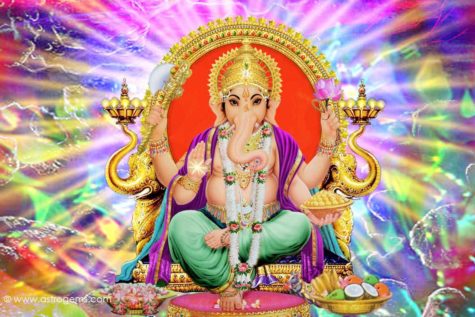
A Reverent Doxology by a Saiva Acharya
Loving Ganesha! Dear to Shiva’s men,
Within whose form the world of form resides,
Who earned the mango by a ponderous ken
And made the moon to wax and wane in tides.
Aum Ganesha! Loved by saints and sages,
Whose skillful arms five potent shaktis wield
To guide men now as in forgotten ages-
The seeker’s shield, the farmer’s fertile field.
Aum! Ganesha’s first shakti is home life,
Protection, harmony, fertility-
Respect becomes the man, as love the wife,
Obedience their cherished offspring’s glee.
Aum! Ganesha’s second shakti’s family –
By blood, by marriage and proximity.
Word and thought controlled, like minds agree,
While faithful friends preserve community.
Aum! Ganesha’s third shakti is the market,
Where commerce earns the earth stability,
Where forthright, selfless merchants, free from debt,
Conceive, produce, exchange prosperity.
Aum! Ganesha’s fourth shakti brings culture-
Refined expression, graceful artistry
In music, dance, in poetry and sculpture
Or common conduct performed consciously.
Aum! Ganesha’s fifth shakti is dharma-
Fair merit found in virtue’s charity
Where love of God does conquer ancient karma
And Liva’s slaves earn grace’s rarity.
Jaya Ganesha! Come, our hearts protect
From discord in the home, from strife with friend,
From business misfortune, from art’s neglect,
From soul’s dark night- these griefs asuric end.
